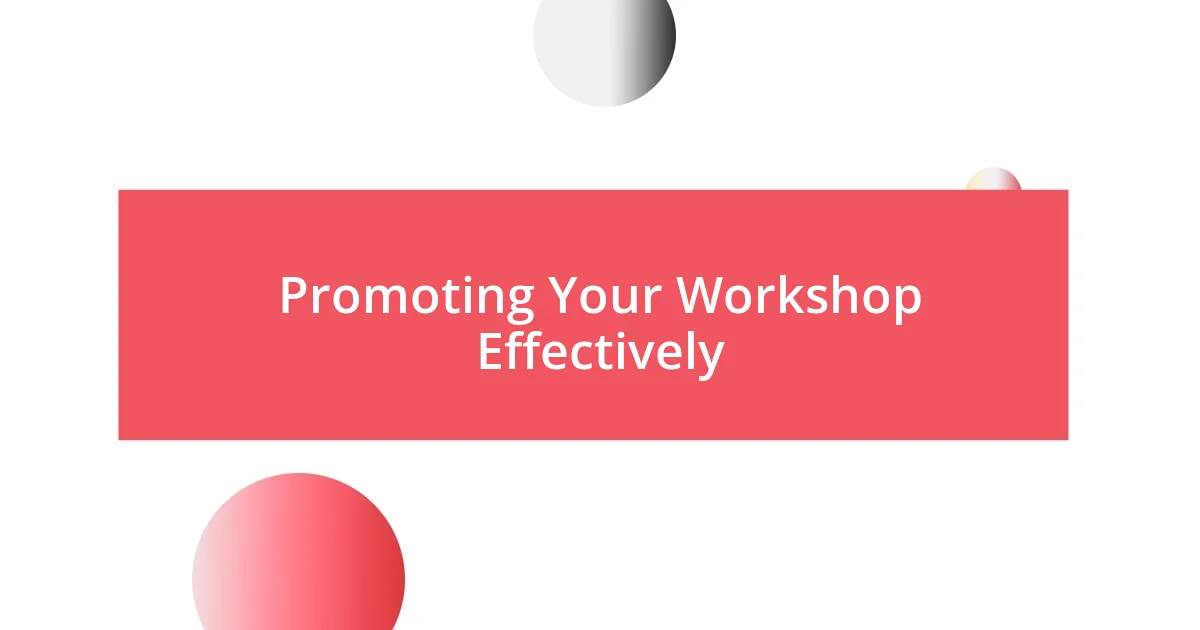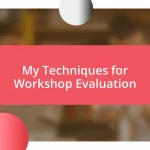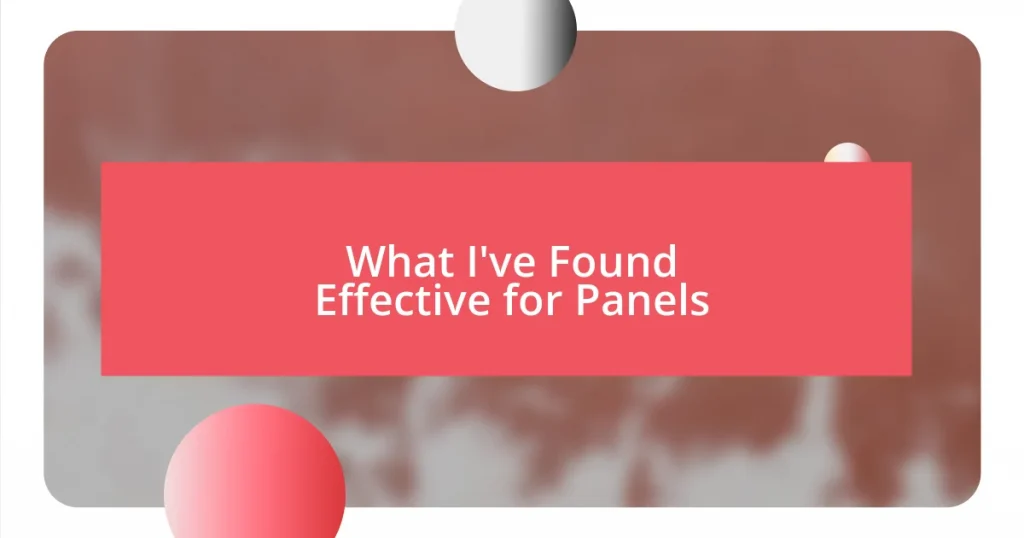Key takeaways:
- Choosing a location that is accessible and surrounded by a vibrant environment fosters community engagement and creativity.
- Establishing shared community values, such as inclusivity and collaboration, strengthens relationships and guides interactions among participants.
- Regularly evaluating community experiences through feedback and check-ins enhances engagement and promotes personal growth within the workshop.

Finding the Right Location
Finding the right location for your workshop community is often one of the most crucial steps in the process. I remember grappling with this decision myself, feeling the weight of choosing a space that would not only accommodate our needs but also foster a sense of belonging. Have you ever thought about how a location influences the atmosphere? It’s a game changer.
One thing that stood out to me was accessibility. I chose a spot that was easily reachable by public transport because I wanted everyone to feel welcomed, regardless of their situation. When I saw participants arriving with smiles, knowing they didn’t have to struggle to get there, it filled my heart with joy – that sense of community was growing right before my eyes.
I also considered the surroundings. Was it in a bustling area or a quiet nook? Initially, I feared being in a busy location might distract us, but I soon discovered the vibrancy around us sparked creativity and conversation. Isn’t it interesting how the environment plays such a pivotal role in shaping the experiences we create? It was a beautiful reminder that inspiration often lies in the places we inhabit.

Designing Your Workshop Space
When it came to designing my workshop space, I quickly realized that functionality and aesthetics go hand in hand. I opted for a layout that encouraged interaction, with a central communal area surrounded by distinct workstations. I vividly recall the excitement of setting up a cozy corner with plants and comfortable seating — that little nook became a sanctuary where ideas flowed freely, and friendships blossomed.
Here are some key considerations I focused on while designing the space:
- Flexibility: I ensured the furniture could be rearranged easily for different activities.
- Lighting: Natural light became my best friend; it brightened the room and lifted everyone’s moods.
- Tools and Equipment: I strategically placed essential tools within reach, making it easier for participants to engage with projects.
- Acoustic Balance: I thought carefully about sound absorption; adding textiles created a warm atmosphere without distracting echoes.
- Personal Touches: Adding artwork and personal items made the space feel welcoming and authentic.
Creating this environment not only facilitated productivity but also sparked joy and connection among participants. It’s amazing how the right design can transform a mundane space into a thriving hub of creativity.

Establishing Community Values
Establishing a set of community values was a foundation for my workshop experience. I realized early on that articulating shared values helped in shaping our identity and guiding our interactions. Inclusivity was my top priority — reflecting on my own experiences, I understood how isolating it felt to be on the outside. I wanted every participant to feel like they belonged, fostering a supportive environment where everyone could grow and share freely.
Crafting our community values involved open discussions with participants. I facilitated workshops where everyone could voice what mattered most to them. I recall one session that sparked a passionate debate about creativity versus productivity. It was enlightening to see how different perspectives brought us closer, turning our discussions into defining principles we all believed in. It became clear that our collective values were not just guidelines; they were the heartbeat of our community.
Ultimately, I recognized that the better we aligned with our values, the more cohesive our community became. When we dared to hold each other accountable and celebrate our differences, it transformed my workshop into a vibrant collective of inspired individuals. I often think, what would have happened if I hadn’t taken the time to establish these values? It’s hard to imagine the warmth and connectivity dissolving without that foundation.
| Community Value | Description |
|---|---|
| Inclusivity | Ensuring everyone feels welcome and valued in the space. |
| Collaboration | Encouraging teamwork and shared efforts in projects. |
| Creativity | Fostering an environment where creative expression is celebrated. |
| Accountability | Maintaining commitment to our values as a community. |

Organizing Engaging Activities
Organizing engaging activities is about creating spaces where creativity can thrive. I remember planning an open-mic night, where participants could share their projects and ideas. The atmosphere buzzed with nervous anticipation—who would take the stage first? By the end of the evening, the excitement had transformed into applause and encouragement, building bonds between participants that still resonate today.
It’s essential to consider diverse interests when planning events. One time, I organized a collaborative art project, inviting everyone to contribute a small piece to a larger mural that represented our community’s journey. Watching shy individuals step forward to paint their part was a revelation. It made me ponder: how often do we underestimate each other’s talents? Those moments of vulnerability not only elevated the artwork but also deepened our connections, resulting in conversations that flowed naturally around the easel.
Variety is crucial too; mixing structured events with spontaneous ones keeps the energy alive. I’ve found that incorporating surprise challenges—like a quick design sprint or a themed potluck—can spark unexpected excitement. Reflecting on my experience, how could anyone resist the allure of creativity when it’s presented with an element of surprise? Each activity became a platform for collaboration and fun, reinforcing the very essence of our workshop community.

Promoting Your Workshop Effectively
To promote your workshop effectively, leveraging social media has been a game-changer for me. I vividly remember my first Instagram post announcing an upcoming session; the excitement in the comments was palpable. It made me think—what if we could turn our online interactions into in-person connections? By sharing behind-the-scenes updates and participant success stories, I created a buzz that not only attracted newcomers but also engaged existing members.
Another effective tactic was creating partnerships with local businesses and influencers. When I reached out to a nearby café to host a networking event, they happily agreed to give us free coffee in exchange for exposure on my channels. This collaboration not only helped in promoting the workshop but also fostered a sense of community around local support. It’s fascinating to see how these partnerships can flourish; if a local influencer shares our events, doesn’t that widen our reach exponentially?
I also learned that word-of-mouth is incredibly powerful. During one workshop, a participant shared their experience on their blog, and suddenly, I was getting inquiries from people I hadn’t even considered as part of my target audience. It made me realize how personal, relatable stories can resonate far beyond our immediate circles. How often do we underestimate the impact of our participants? Their voices can be our most authentic marketing tool.

Building Lasting Relationships
Building lasting relationships within a workshop community often comes down to the little things we do every day. One memorable instance for me was when I took the time to remember and celebrate everyone’s birthdays. It might seem simple, but walking into the workshop one day to find a handmade cake and decorations was pure magic. The smiles exchanged during those celebrations forged connections that felt deeper—people opened up about their lives, dreams, and challenges. Isn’t it fascinating how a small gesture can cultivate a sense of belonging?
Another powerful moment occurred during a particularly challenging project. I noticed a few members struggling and decided to hold a feedback circle—an open forum for sharing thoughts and helping each other out. As we discussed challenges and provided support, I was amazed by the warmth that filled the room. Suddenly, people who were once distant started sharing their personal stories, worries, and victories. Have you ever seen a group transform simply by choosing empathy over competition? Those conversations not only built trust but also solidified friendships that extended well beyond our workshops.
I’ve learned that vulnerability plays a crucial role in building relationships too. Recently, I shared my own hesitations on a new project, and to my surprise, several participants admitted they felt the same way. In that moment, we shifted from being mere acquaintances to a close-knit community, where we actively supported each other. The question came to mind: how often do we dismiss the power of honesty? Embracing this vulnerability created a safe space, turning our workshop into a supportive haven for growth and collaboration.

Evaluating and Improving Community Experience
Evaluating and improving the community experience is an ongoing journey that requires a keen eye and an open heart. I remember when I first implemented feedback forms after each workshop, thinking they’d be just another task to cover. But, surprisingly, the insights shared were invaluable. Did you ever expect a simple question like “What did you enjoy most?” could spark a lively discussion? Those responses brought forth ideas I never would have considered on my own, and it was incredible to see my workshop evolve based on the community’s voice.
I’ve also found that hosting regular check-in sessions can significantly enhance the overall experience. I once dedicated a workshop to just talking—no agenda, no pressure. Participants shared their thoughts, feelings, and any hurdles they were facing. To my surprise, listening became a transformative tool. Isn’t it interesting how simply giving your community a platform to express themselves can lead to newfound energy and connection? The genuine interactions that emerged made everyone feel more invested in the group, reinforcing our collective purpose.
Moreover, I learned that creating opportunities for peer mentorship can strengthen bonds and enrich the community. I started a buddy system, pairing experienced members with newcomers, and the results were heartwarming. Witnessing the friendships blossom and hearing stories of triumph shared over coffee breaks filled me with joy. Doesn’t it feel like magic when you facilitate relationships that empower everyone involved? This approach not only improved the atmosphere of the workshops but also fostered personal growth for both mentors and mentees. The experience reminded me that community isn’t just about being together; it’s about lifting each other up along the way.















